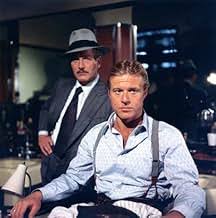Directed by George Roy Hill and starring Paul Newman and Robert Redford, is a stylish caper film set in 1936 Chicago. It tells the story of two con men, Johnny Hooker (Redford), a small-time grifter, and Henry Gondorff (Newman), a seasoned swindler, who team up to take down Doyle Lonnegan, a ruthless crime boss responsible for the murder of Hooker’s partner.
The film opens with Hooker pulling a successful con, only to have it traced back to Lonnegan, who orders a hit in retaliation. Hooker flees to Chicago, seeking Gondorff’s help for a long con—an elaborate, multi-layered scam—to exact revenge. The duo assembles a team of fellow grifters to stage a fake off-track betting operation designed to lure Lonnegan into a trap.



The brilliance of The Sting lies in its intricate plotting and the way it draws both Lonnegan and the audience into the deception. Each scene layers misdirection, leading to a suspenseful and satisfying climax. A standout element is the film’s use of ragtime music, particularly Scott Joplin’s “The Entertainer,” which became iconic after the film’s release.
With clever writing, charismatic performances, and a twist-filled narrative, The Sting is not just a heist movie—it’s a homage to classic confidence games and a study in performance and illusion. The film was a massive critical and commercial success, winning seven Academy Awards including Best Picture, Best Director, and Best Original Screenplay. Its timeless appeal comes from its wit, elegance, and the electric chemistry between Newman and Redford, who had previously starred together in Butch Cassidy and the Sundance Kid.
The Sting remains a gold standard for con artist films, admired for its craftsmanship, charm, and the sheer fun of watching a perfectly executed long con.
